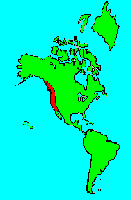SPECIES INFO
Incense cedar (Libocedrus decurrens to Calocedrus decurrens) can be found from Oregon south through California to Baja California. This can also be found in western Nevada. This tree can grow to about 150 feet tall. The lower branches curve downward and the upper branches are erect. The bark is thin and is cinnamon-brown.Incense cedar genus (Calocedrus) contains three species of large trees. One is found in western North America, one is found on Taiwan, and the 3rd species is found in China. The largest is the North American species which can grow to about 150 feet tall. The Chinese one grows to about 100 feet tall, and the Taiwan(=Formosa) one grows about 60 feet.
Juniper (Cupressaceae family) group contains about 120-140 species worldwide with about 14-17 different genera. Included herein are the Juniperus and Cupressus genera. (Some authors include the Taxodiaceae (Taxodium and Sequoia) genera here. Here they are kept separate and placed in the Taxodiaceae family.) Following are some of the genera included herein:
Callitris,Callitropis,Chamaecyparis,Cupressus,Diselma,Fokenia, Libocedrus,Thuja,Thujopsis
Conifers (Order Coniferae) is an important group of trees and bushes found throughout the world. Although very common in the forests everywhere, this group of plants has only about 520 species. They are characterized by having needles or scales. Pines, spruces, yews, redwoods, and junipers are typical examples of conifers.
Most of these plants have cones, but some members have berry like fruits.
Gymnosperms are a group of trees and bushes usually characterized by needles (some have scales) and the production of cones to support the seeds. Most species are evergreen. (The actual technical definition has to do with the method of producing the seed.)
There are over 600 species of Gymnosperms known to science. The largest genus in this group in terms of species is the Pine genus with about 120 species. The second most common genus is the Podocarpus genus which is normally a more tropical group than the Pines.
Kartesz lists 135 species as growing in greater North America, including Hawaii, Puerto Rico, and the Virgin Islands.
Seed plants (Phylum Embryophyta) are generally grouped into one large phylum containing three major classes: the Gymnosperms, the Monocots, and the Dicots. (Some scientists separate the Gymnosperms into a separate phylum and refer to the remaining plants as flowering plants or Angiospermae.)
For North American counts of the number of species in each genus and family, the primary reference has been John T. Kartesz, author of A Synonymized Checklist of the Vascular Flora of the United States, Canada, and Greenland (1994). The geographical scope of his lists include, as part of greater North America, Hawaii, Alaska, Greenland, Puerto Rico, and the Virgin Islands.
Kartesz lists 21,757 species of vascular plants comprising the ferns, gymnosperms and flowering plants as being found in greater North America (including Alaska, Hawaii, Greenland, Puerto Rico and the Virgin Islands.
There are estimates within the scientific world that about half of the listed North American seed plants were originally native with the balance being comprised of Eurasian and tropical plants that have become established.
Plant kingdom contains a large variety of different organisms including mosses, ferns, and seed plants. Most plants manufacture their energy from sunlight and water. Identification of many species is difficult in that most individual plants have characteristics that have variables based on soil moisture, soil chemistry, and sunlight.
Because of the difficulty in learning and identifying different plant groups, specialists have emerged that study only a limited group of plants. These specialists revise the taxonomy and give us detailed descriptions and ranges of the various species. Their results are published in technical journals and written with highly specialized words that apply to a specific group.
On the other hand, there are the nature publishers. These people and companies undertake the challenging task of trying to provide easy to use pictures and descriptions to identify those species.
